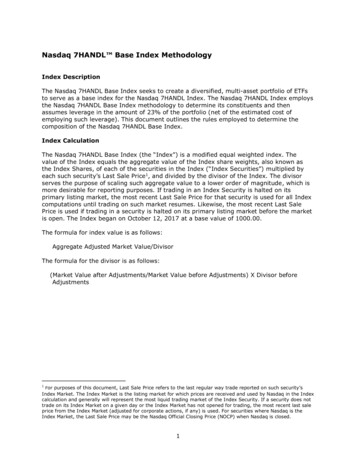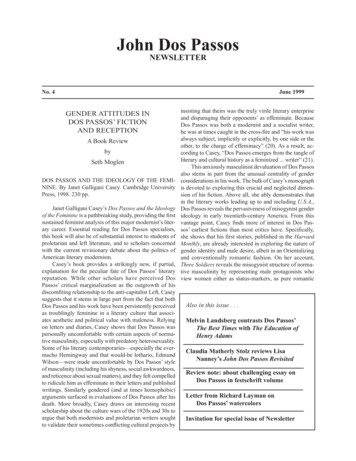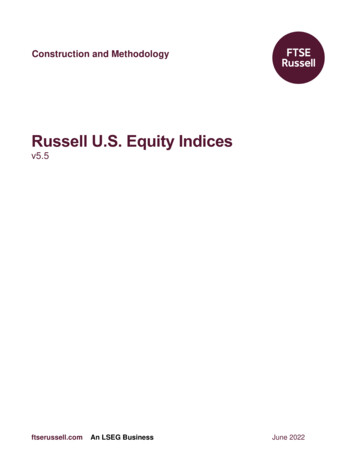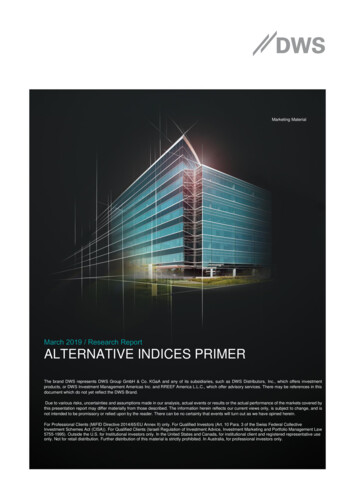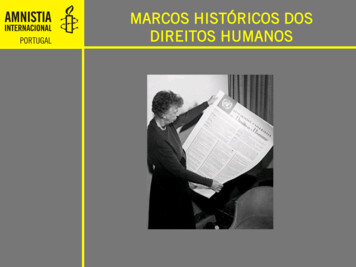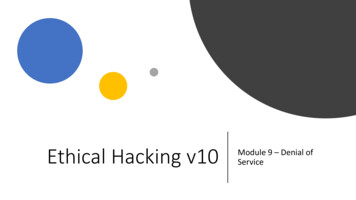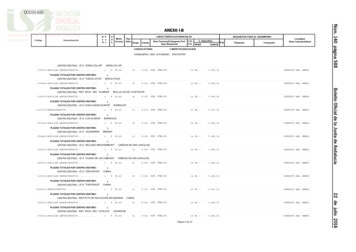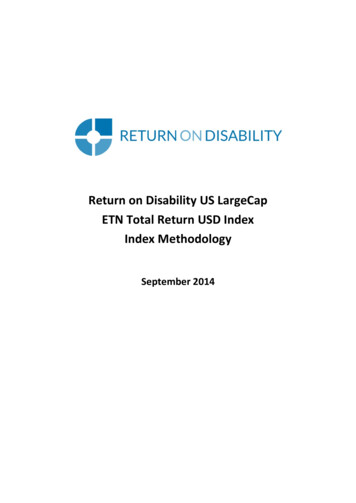![Index [ Firemarshal.dos.nh.gov]](/img/45/nh-fire-and-all-hazards-mobilization-plan.jpg)
Transcription
s
IndexSection 1AUTHORITYAgreement3Purpose3Scope4Key Concepts & Incident Responsibility4Authority5Plan Maintenance9Section 2OPERATIONAL CONCEPTSTraining Competencies/Physical Capabilities10Communications10Facilities/Personnel and Equipment10Section 3OPERATIONSOperationsTime Frame for Deployment12Logistical SupportSelf ContainedForce protection13Dispatch MethodologyKey Words/DefinitionsSummaryPoints to Remember14Concept of Operation Flowchart16Requesting Community Procedures17Fire Mobilization Plan Control Center Procedure17Sending Mutual Aid District Procedure17Task Force/Strike Team Leader Procedure181
Task Force / Strike Team Organization19Recommended Practices19Code of Conduct19Section 4ADMINISTRATIVE FRAMEWORKOrganizational Memorandum of Agreement – Approval25Revision Log26Section 5ANNEX272
NEW HAMPSHIRE STATEWIDEFIRE and ALL HAZARDSMOBILIZATION PLANApproved September 19, 2001Revised – 09/22/21AGREEMENTThis operating agreement is entered into, by and between the Border Area Mutual Aid Association,Southwestern New Hampshire District Fire Mutual Aid, Souhegan Mutual Fire Aid Association,Seacoast Chief Fire Officers Mutual Aid District, Upper Valley Fire Mutual Aid Association, CapitalArea Mutual Aid Fire Compact, North Country Fire Mutual Aid District, Twin State Mutual Aid FireAssociation, Lakes Region Mutual Fire Aid Association, Kearsarge Mutual Aid, Ossipee Valley MutualAid Association, Division of Forests and Lands, and the State Fire Marshal pursuant to New HampshireRSA Title 3, Chapter 53-A.PURPOSEThe purpose of the State-wide Fire & All Hazards Mobilization Plan (hereafter known as the Plan) is toprovide local first responders with easy access to large quantities of resources or specialties that may beneeded in a major fire, disaster or other major emergency or event in the State of New Hampshire andelsewhere.The Plan is based on a series of observed occurrences and shared experiences during recent disasters andmajor emergencies in the State of New Hampshire. It is also an evolution of our past experiences indealing with the day-to-day incidents that continually challenge our resources and competencies. Mostimportantly, it is a practical approach to provide emergency service resources in quantities or specialtiesbeyond the means of any single department. It is to the mutual advantage of the parties hereto tocooperate for the purpose of Fire and related incidents that are beyond the capabilities of local andregional emergency response organizations.The Plan was developed to provide for the systematic mobilization, deployment, organization andmanagement of emergency services resources to assist local agencies in a major fire, disaster or othermajor emergency. This enabling agreement is not obligatory and does not guarantee that anyaforementioned parties will respond into other districts. Response will be provided based upon availableresources.3
SCOPENew Hampshire is susceptible to natural and man-made disasters; therefore accentuating the need forthis level of coordination and preparation. The effective management of emergency response personnelduring the incipient stage of any major incident and throughout its extended operations will by far, havethe most significant impact on life loss and the severity of injuries to the affected population. The Planprovides for the activation and sustained response of aid to a community in the event of a localizeddisaster. These events can include, but are not limited to, major fires, tornadoes, train derailments,hazardous materials incidents, wildland fires, domestic terrorism and other events that may overwhelmthe local fire department serving the community and its normal mutual aid resources.Requests for assistance should be referred to the appropriate dispatch center. This Plan serves as themechanism to commit local fire, EMS and special resources to emergencies beyond the scope of theirnormal mutual aid systems. It is important to understand that the control of an incident will remain in thehands of the local jurisdiction.KEY CONCEPTS & INCIDENT RESPONSIBILITYResponsibility for planning, initial response, direction and control rest with the affected localcommunity. The Plan is directed toward enhancing disaster management at the local, county and statelevel of government by:-Providing a simple method to immediately activate large quantities of fire, EMS andspecialized personnel and resources.Establishing the positions, roles, and responsibilities necessary to activate and maintain thisplan.Complimenting other disaster plans at the local and state level.Utilizing the Incident Command System (ICS) and the principles of the National IncidentManagement System (NIMS) which have been adopted by the State of New Hampshire.This Memorandum of Agreement neither expands nor abridges any rights and responsibilities of anyparties, including responsible parties, not signature to this agreement pursuant to RSA 154.4
SECTION 1: AUTHORITYAid Outside DistrictSection 154:24154:24 Outside Service by Local Fire Department. – Any city, town, village or fire district may authorizetheir respective fire department to go to the aid of another city, town, village or fire district within or without thestate, for the purpose of extinguishing a fire, rendering other emergency assistance, or performing any detail asrequested.Source. 1949, 267:1. RSA 154:24. 1992, 154:15, eff. July 5, 1992.Section 154:25154:25 Rights, Privileges, Immunities. – While in the performance of their duties in extending such aid,firefighters shall be subject to the control and direction of the chief fire official of the municipality within whichthe fire or other emergency occurs, and they shall have the same immunities and privileges as if performing thesame duties within their respective city, town, village or fire district.Source. 1949, 267:1. RSA 154:25. 1992, 154:16, eff. July 5, 1992.Section 154:26154:26 Loss or Damage. – Any expenses incurred by any fire department, in rendering such aid outside thelimits of its jurisdiction as provided hereunder, including loss or damage to equipment may be charged to thecity, town, village or fire district whose officials requested such aid.Source. 1949, 267:1, eff. June 22, 1949.Section 154:27154:27 Donation of Services. – Nothing contained herein shall be construed to prohibit any city, town,village or fire district extending such aid from donating their equipment and services and assuming the damageor loss to their equipment.Source. 1949, 267:1, eff. June 22, 1949.Section 154:28154:28 Conditions and Restrictions. – The fire department may extend such aid outside the district, underthis subdivision, subject to such conditions and restrictions as may be prescribed.Source. 1949, 267:1. RSA 154:28. 1992, 154:17, eff. July 5, 1992.Section 154:29154:29 Compensation. – Any city, town, village or fire district aided under and in accordance with RSA154:24-28 may compensate any city, town, village or fire district rendering aid to (a) employees forcompensation during the time in which the rendering of their services prevented them from performing theirregular duties at their place of employment, and (b) may reimburse in part or in whole for any paymentslawfully made to any member of its fire department or to a spouse or other dependents on account of injuries ordeath suffered by the fire department member in the course of rendering aid outside the district or of deathresulting from such injuries.Source. 1949, 267:1. RSA 154:29. 1992, 154:18. 1998, 318:29, eff. Aug. 25, 1998.5
Section 154:30154:30 Duties of the State Fire Marshal. – At the request of any chief of an organized fire departmentwithin the state, the fire marshal shall provide help and assistance in coordinating the services of firedepartments giving the mutual aid in the extinguishment of fires and other emergencies.Source. 1949, 267:1. RSA 154:30. 1992, 154:19, eff. July 5, 1992.District Fire Mutual Aid SystemsSection 154:30-a154:30-a Formation. - I. Whenever 10 or more municipalities within the state shall have voted to authorizetheir respective fire departments to render outside aid as provided in RSA 154:24-30, they may, if they sodesire, form a district fire mutual aid system, which shall be a public municipal corporation. They may petitionthe state fire marshal in writing to call the organizational meeting of the system.II. Fewer than 10 municipalities which have complied with paragraph I of this section may petition the statefire marshal who may accept or reject the petition. The state fire marshal shall consider the fire protection needsof the applicants and the effect of the proposed system upon the fire protection of other municipalities.Source. 1957, 277:1. 1992, 154:20, eff. July 5, 1992.Section 154:30-b154:30-b Organization. - I. Upon receipt of a petition under RSA 154:30-a, I, the state fire marshal shall callthe first or organizational meeting of the system. Upon receipt of a petition under RSA 154:30-a, II, the statefire marshal may call such a meeting. The state fire marshal shall give written notice to the chief of each firedepartment in the system and may invite private fire departments within the designated area to join in themeeting by giving similar notice to them. Each fire department shall send one delegate to the organizational andsubsequent meetings and shall be entitled to one vote in all proceedings. The delegate shall be the chief of eachfire department or such alternate as the chief may designate. At the organizational meeting, the members of thesystem shall adopt articles of association and bylaws and regulations for the future government and operation ofthe system which shall be effective upon submission to and approval by the attorney general, who shall causethe same to be recorded by the secretary of state. The system shall be deemed to have been formally establishedupon such recording. The organizational meeting shall also elect a board of directors consisting of such numberas they may determine. Delegates and directors need not be residents. The board of directors shall be thegoverning body of the system and shall serve for terms of one year and until their successors are elected andqualify, provided that the organizational meeting, or any subsequent meeting, may vote to elect its directors forvarying terms. If a meeting shall so vote for the first election under said vote one director shall be elected for aterm of one year, one for a term of 2 years, one for a term of 3 years, one for a term of 4 years, and one for aterm of 5 years, and thereafter there shall be elected at each annual meeting one director for a term of 5 yearsand until a successor is elected and qualified.II. The directors shall choose from their number the officers of the system, who shall have such duties andpowers them.Source. 1957, 277:1. 1959, 198:1. 1992, 154:21. 1998, 318:30, eff. Aug. 25, 1998.Section 154:30-c154:30-c Powers and Duties. –I. A district fire mutual aid system shall coordinate the services of all6
municipalities and fire departments belonging to it so as to provide better and more efficient cooperation in theprotection of life and property within the area which it comprises and toward this end shall cooperate with otherstate agencies including the division of homeland security and emergency management and local emergencymanagement offices.II. A district fire mutual aid system may:(a) Establish plans for the coordination of all municipal services performed by it;(b) Within the limits of available funds, acquire and operate property and equipment, including a dispatchcenter;(c) Provide communications service, radio repair, and maintenance service to its member municipalities andfire departments or persons and firms under contract with a member municipality or fire department;(d) Provide private fire, burglary, and supervisory alarm service;(e) Provide dispatch and communications service for police and emergency medical services of membermunicipalities and fire departments or for such services as are under contract with member municipalities andfire departments;(f) Extend the advantages of group purchasing for services performed by it to municipalities and firedepartments in the system; and(g) Provide and operate training programs for firefighters and emergency medical technicians.III. The state fire marshal may render advice, recommendations and assistance to any district fire mutual aidsystem.Source. 1957, 277:1. 1981, 393:1. 1992, 154:22. 1993, 28:7, eff. Jan. 1, 1994. 2003, 319:126, eff. Sept. 4, 2003.2004, 171:18, eff. July 24, 2004. 2008, 361:15, eff. July 11, 2008.Section 154:30-d154:30-d Joining and Withdrawal. – Additional municipalities within or outside the state may join thesystem, as provided in RSA 154:30-a through RSA 154:30-h, and shall be received as members subject to theapproval of the board of directors. Municipalities which do not have active fire departments may be admitted asmembers upon such conditions as the board of directors may fix. Private fire departments within or outside thestate may also be accepted as members, with equal voting rights, by the board of directors, under sucharrangements as are mutually agreed upon. A municipality or private fire department may, by vote of itsgoverning board, withdraw from the system but such withdrawal shall not be effective until 90 days afterwritten notice of such withdrawal shall have been delivered to one of the officers of the system.Source. 1957, 277:1. 1977, 321:1. 1992, 154:23, eff. July 5, 1992.Section 154:30-e154:30-e Limitation of Liability. – There shall be no liability imposed by law on the system or on anymunicipality, on the personnel of its fire department, nor on any private fire department or its personnel,belonging to such a system, for failure to respond or to respond reasonably for the purpose of extinguishing anyfire. This immunity is not intended to be exclusive of other immunities existing by statute or at common law.Source. 1957, 277:1, eff. Oct. 1, 1957.Section 154:30-f154:30-f Appropriations. – Municipalities belonging to such a system may raise and appropriate money forthe purpose of the system. Counties in which a system is established may raise and appropriate money for thepurposes of the system; provided however that where all the municipalities in the county do not belong to thesystem, such county appropriations may only be made by the affirmative vote of 2/3 majority of the county7
convention present and voting.Source. 1957, 277:1, eff. Oct. 1, 1957.Section 154:30-g154:30-g Definition. – The term "private fire department'' as used in this subdivision shall include fireorganizations operated by industries and establishments for self-protection and also nonprofit volunteer fireassociations. Nothing contained in this subdivision shall be construed to interfere with the exclusive jurisdictionvested by law in the director, division of forests and lands, department of natural and cultural resources, and thedirector's subordinates over forest fires as provided in RSA 227-L, nor to affect the laws governing preventionor extinguishment of forest fires.Source. 1957, 277:1. 1995, 299:9, eff. Jan. 1, 1996. 2017, 156:14, I, eff. July 1, 2017.Section 154:30-h154:30-h Gifts. – A district fire mutual aid system may receive, hold and use gifts, bequests and devises,either outright or in trust, for purposes consistent with this subdivision.Source. 1959, 198:2, eff. Sept. 20, 1959.8
PLAN MAINTENANCEFederation of Fire Mutual Aids Mobilization Plan Working GroupThe maintenance of the Plan, including its development, revision, distribution, training and exercising isthe responsibility of the New Hampshire State Fire Marshal, and New Hampshire Federation of FireMutual Aids in coordination with its member organizations.Revision ProcessThe Plan will be reviewed biennially by members of a stakeholders working group. The Federation incoordination with the stakeholders working group is authorized to publish changes to the Plan asnecessary. During the interim period between the biennial reviews, recommendations for revision willbe forwarded to the Federation for distribution to and concurrence by the stakeholders working group.All changes to the Plan will be documented and included in a Plan Revision Log. This log will bemaintained by the Federation and incorporated as part of the Plan. Additionally, a record of thoseserving on each review process will be documented and included in the Plan Revision Log.The State Fire Marshal and the Federation will maintain an updated version of the Plan, including allrevisions.9
SECTION 2: OPERATIONAL CONCEPTSTRAINING COMPETENCIES/PHYSICAL CAPABILITIESThe sending agency has the responsibility to ensure that personnel are trained to a basic level ofproficiency based upon the mission. In addition, all responding personnel must be NIMS compliant.All responding personnel should meet the minimum level of certification as provided by the appropriatestate agency and/or meet the appropriate nationally recognized standards of the National EmergencyResponder Credentialing System for the position to be filled.Additionally, personnel responding to an activation of the plan shall be in physical conditioncommensurate with the expected tasks to be performed and conditions to be faced.Such assurances for NIMS compliance, training competencies and physical ability must come from theauthority sending the assistance and be capable of being proved by audit.All parties to this agreement agree to exchange training opportunities, share planning documents,resource listings and standard operating guidelines.COMMUNICATIONSThe key to the successful operation of the various resources in a region will depend heavily upon theability of these agencies to communicate effectively with each other. It is realistic to assume that in thewake of a major disaster, the existing communication system in the affected area may have beenimpacted. By the terms of this agreement, each party agrees to permit the others to utilize radiofrequencies, computers, telephones and pagers for emergency response. Primary communications forTask Force/Strike Team mobilization will be conducted on public safety interoperability zone “H”.Utilization of Communications Unit Leaders, Mobile Command Post and Vehicles may help to achieveinteroperability.NIMS requires the use of Plain Language for all voice transmissions. Adherence to this principle isespecially critical when an incident involves multiple types of agencies. Use of codes that are notunderstood by all participants could lead to confusion and reduced effectiveness.FACILITIES/PERSONNEL AND EQUIPMENTEach Mutual Aid District shall make facilities available upon reasonable request for training and storageas negotiated.Each Mutual Aid District will maintain a list of personnel and equipment available to other Districts.This database will be the primary source for identifying potential equipment, vehicle and personnelresources.Participating Mutual Aid Districts agree to provide the New Hampshire Federation of Mutual AidDistricts with changes to task force components and District contact information.10
Resource Typing: Resource typing will be consistent with the most current edition of FEMA/NIMSIntegration Center’s Resource Typing Definitions Library or State Resource Typing Documentcontained in Annex D11
SECTION 3: OPERATIONSWhen any District requests assistance from another, the sending fire department shall dispatch only personnelwho meet or exceed minimum requirements for certification and training and physical standards as set forth bythe appropriate state agency and/or the appropriate nationally recognized standard.At the time of the request the assisting District(s) shall dispatch the appropriate available resources inaccordance with the Resource Typing specified in this plan’s methodology.All Districts will operate using the Incident Command System and NIMS Standards.TIME FRAME FOR DEPLOYMENTRapid Response: In many emergency situations, a rapid deployment may be deemed necessary andauthorized as a Rapid Response. Time frame for deployment of these missions shall be as soon aspossible, preferably within 1 hour of notice of dispatch and authorization. Unless otherwise stated, theanticipated duration of the deployment will be up to 24 hours. The request will direct the deployingresources to respond to the designated Staging Area or check-in area identified by the IC. Respondingunits should plan to be self-sufficient for the length of the assignment.Standard Deployment: Unless specified otherwise at the time of request, the standard for deploymentof resources shall be within three (3) hours of notice from the Dispatch/authorization. Anticipateddeployment should be expected to not exceed seventy-two (72) hours. Deployed resources shall reportto the designated location identified in the deployment request. All personnel responding on a StandardDeployment should be self-supporting for up to twenty-four (24) hours.Extended Deployment: Unless specified otherwise at the time of request, the standard for deploymentof resources shall be within twenty-four (24) hours of notice from the Dispatch/authorization.Anticipated deployment should be expected to exceed seventy-two (72) hours. Deployed resources shallreport to the designated location identified in the deployment request. Extended deployment ofpersonnel shall not exceed fourteen (14) days exclusive of travel days.Demobilization: It shall be policy to release assisting District(s) from duty as soon as practical andmutually agreed. Demobilization from incidents will be relayed through appropriate dispatch channels tonotify home units of release of their resources. Demobilization should be coordinated and completed inaccordance with the ICS principles of NIMS. A demobilized task force will be under the control of itsLeader until arrival at its home jurisdiction.Self-Dispatching: Fire Department, EMS units and/or individuals shall not self-dispatch to theMobilization Plan activation. To ensure proper dispatch authorization the Staging Area shall have arecord of requested resources to validate access to the incident. It is the responsibility of local officialsand dispatch centers to take aggressive action to insure that such resources are not utilized. There shallbe no funding support or reimbursement provided to self dispatched units or personnel.POV’s (personally owned vehicles): All responses should be in department vehicles designed andequipped for the intended use. This response method will help to assure that resources used will have the12
proper vehicle liability insurance coverage. Transportation of manpower may be by private vehicle butuse of official vehicles is preferred.LOGISTICAL SUPPORTThe logistical support of resources is critical in the management of a disaster effort. Logistical supportwill be established as soon as possible and will be maintained by the agency requesting the resources.Responding resources on a Standard or Extended Deployment should be prepared to be self-containedfor up to twenty-four (24) hours.-The receiving agency should provide food, water, and shelter for up to seventy-two (72) hoursfor responding personnel.When responding to a Deployment, personnel should bring medicine, clothing and personalhygiene items to support themselves for not less than the duration of deployment.Force ProtectionProtection of responders will be coordinated at the local level or with ESF 13 (Public Safety andSecurity) if it is available based on the nature of the mission and extent of risk to those responders. Thisprotection may include but not be limited to:-Protection of personnel and equipment while in transitPerimeter and access security to the incident areaSecurity at the Base of OperationsProtection during search & rescue operationsProtection during EMS triage, treatment and transport operationsProtection during fire operationsDetainment of self-dispatched apparatus and personnelThe primary mission of the force protection resources is to assess and detect hostile activity before itbecomes a risk to operations.13
DISPATCH METHODOLOGYKEY WORDS/DEFINITIONSAssembly Point -A location where task forces are designated to meet and form a convoy torespond to an incident.Command Post Location of the Incident Commander and Command Staff.District Control Center - The fire mutual aid control center for dispatching.District Fire Coordinator - The president or designee of each participating mutual aid district.Incident Commander The Head of the Local Fire Department authorized subordinateresponsible for the entire operation.Staging Area A reception area designated to receive incoming forces.Strike Team -A Strike Team Leader and a group of five single pieces of the same kindand type of apparatus.One (1) Strike Team Leader, five (5) forestry engines.Five (5) four person crews (Type II or Type III)Strike Team Forestry Strike Team Crew (Forestry)Strike Team Crew (EMS) – Five (5) four person crews (Licensed EMR MinimumStrike Team (Ambulance)- One (1) Strike Team Leader, five (5) ambulances(EMS level as requested)Task Force Task Force Disaster Task Force Forestry Task Force Structural Task Force Tender-A Task Force Leader and a group of resources formed for a specific task.One (1) Task Force Leader, three (3) engines, one (1)ladder, 0ne (1) heavy rescue.One (1) Task Force Leader, one (1) Type I Engine, three (3) ForestryEngines and one (1) tender.One (1) Task Force Leader, four (4) engines, one (1) ladder truck.One (1) Task Force Leader, one (1) engine, four (4) tenders.Dispatch Methodology SummaryThe local incident commander requests aid through their local dispatch center as an incident escalates.The local dispatch center utilizes normal in-district mutual aid from surrounding communities. Whenthis source of mutual aid is depleted and the local incident commander requires additional aid, the localdispatch center will request such aid from the Fire Mobilization Plan Control Center initial point ofcontact which is Capital Area Mutual Aid Fire Compact. The Capital Area Mutual Aid Fire Compact, inconcert with the other Fire Mobilization Plan Control Centers, (Lakes Region Mutual Fire Aid andSouthwestern New Hampshire District Fire Mutual Aid) determines which Control Center will be theprimary control center for this call up. The Primary Control Center, utilizing the State Fire MobilizationPlan, shall request the indicated task force(s) or strike team(s) from the appropriate Mutual AidDistrict(s), notifying them of the situation and the location of the staging area to which their task forceor strike team is to report.The responding Mutual Aid District, utilizing this plan, will activate the appropriate task force or striketeam informing those units of an in-district assembly point. Once assembled, the task force or strike14
team shall respond in convoy to the incident staging area. The responding Mutual Aid District shallnotify the primary control center of the departure and estimated time of arrival. The State Fire Marshalshall be notified of this status. All control centers and the Mutual Aid District (s) shall remain ready toprovide logistical information until the task force or strike team arrives at the staging area and is underthe control of the incident commander.Points to Remember The Statewide Mobilization Plan only comes into effect when the local community resources andthose of its normal mutual aid system are expended.The plan organizes apparatus and personnel in task forces or strike teams. Each has its own TaskForce or Strike Team Leader.The task forces or strike teams meet at an assembly point and travel together. They report to adesignated staging area for assignment.Task forces or strike teams cannot be used for routine cover assignments. Station coverageremains a local mutual aid system responsibility.The Incident Commander must authorize the request for the plan to be implemented. TheIncident Commander assumes overall responsibility.Notification must be made to the State Fire Marshal’s Office when the plan is activated.Task force or strike team apparatus must meet the FEMA Typing Standards. All FireDepartments and mutual aid control centers must issue procedures that reference this plan.Authority for this plan is pursuant to New Hampshire RSA Title 3, Chapter 53-A.Task Forces may be customized depending on the incident conditions but should follow NIMSbest practices15
OPERATIONAL FLOW CHARTWhen Local Incident Exceeds the Ability of the LocalMutual Aid District to Control and more resources areneededThe Incident Commander requests additionalresources, utilizing the Mobilization Plan, from theirDispatch CenterThe Dispatch Center requests a ST/TF from the FireMobilization Plan Point of Contact (Capital Area MutualAid Fire Compact)The Capital Area Mutual Aid Fire Compact (in concertwith Lakes Region and Southwest) selects the PrimaryControl Center for the Sending TF/ST and contacts theSending Mutual Aid District Dispatch CenterThe Sending Mutual Aid District Dispatch Centercontacts the TF/ST Leader, determines the AssemblyPoint and Dispatches the appropriate response assetsTF/ST Leader assembles assets, responds in convoy toRequesting CommunityTF/ST Leader updates Sending Mutual Aid Dispatch;Sending Mutual Aid Dispatch updatesResponding16Departments and Primary Control Center
Requesting Community Procedures/Local Community Procedures:-After all local resources have been exhausted the local incident commander requests a Task ForceStrike Team via their local communications center.-The local communications center contacts Statewide Fire Mobilization Plan Point of Contact(Capital Area) with request for Task Force or Strike Team.-Specify the Staging Area or Location where you want the requested assets to report.-Relay
Key Concepts & Incident Responsibility 4 Authority 5 . regional emergency response organizations. The Plan was developed to provide for the systematic mobilization, deployment, organization and . 1949, 267:1. RSA 154:29. 1992, 154:18. 1998, 318:29, eff. Aug. 25, 1998. 6 Section 154:30
